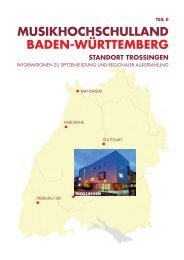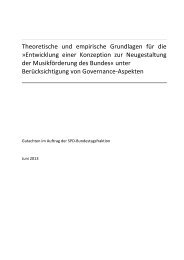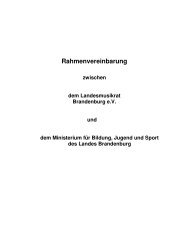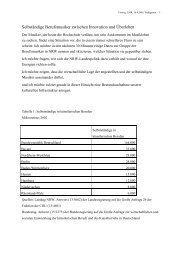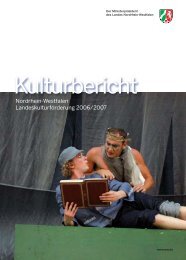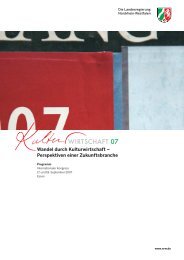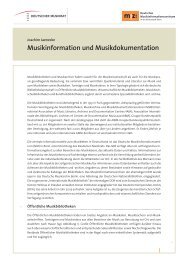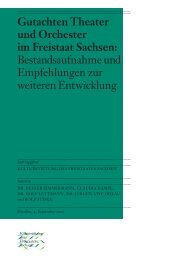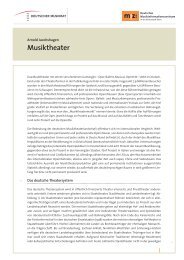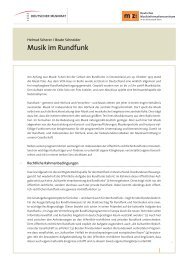SYMPHONY AND CHAMBER ORCHESTRAS - Miz.org
SYMPHONY AND CHAMBER ORCHESTRAS - Miz.org
SYMPHONY AND CHAMBER ORCHESTRAS - Miz.org
You also want an ePaper? Increase the reach of your titles
YUMPU automatically turns print PDFs into web optimized ePapers that Google loves.
Sources: German Music Information Centre,<br />
German Orchestra Association<br />
BERLIN<br />
1 Orchester der Komischen Oper, Berlin<br />
2 Orchester des Metropol-Theaters, Berlin (1997)<br />
3 Rundfunk-Sinfonieorchester Berlin<br />
4 Orchester des Theaters des Westens, Berlin (2001)<br />
5 Konzerthausorchester Berlin<br />
6 Orchester des FriedrichstadtPalastes, Berlin<br />
7 Berliner Philharmoniker<br />
8 Berliner Symphoniker (2004)*<br />
CENTRAL GERMANY<br />
9 Telemann Kammerorchester Michaelstein,<br />
Blankenburg (2000)<br />
10 Orchester der Landesbühnen Sachsen-Anhalt, Eisleben (1992)<br />
11 Orchester der Musikalischen Komödie, Leipzig<br />
12 MDR-Sinfonieorchester, Leipzig (1992)<br />
13 Westsächsisches Symphonieorchester, Böhlen/Leipzig<br />
14 Rundfunk-Blasorchester Leipzig, Bad Lausick<br />
15 Philharmonisches Orchester Altenburg-Gera (2000)<br />
16 Neue Elbland Philharmonie, Riesa (1993)<br />
17 Orchester der Landesbühnen Sachsen, Radebeul<br />
18 Mitteldeutsche Kammerphilharmonie, Schönebeck<br />
RUHR AREA<br />
19 Philharmonia Hungarica, Marl (2001)<br />
20 Bochumer Symphoniker<br />
21 Essener Philharmoniker<br />
STUTTGART<br />
22 Radio-Sinfonieorchester Stuttgart des SWR<br />
23 Stuttgarter Kammerorchester<br />
‘KULTURORCHESTER’<br />
Radio orchestra<br />
Concert orchestra<br />
Theatre orchestra<br />
Chamber orchestra<br />
Orchestra disbanded<br />
since 1990<br />
Red lettering indicates year of dissolution<br />
(in brackets)<br />
Orchestra created by merger<br />
Grey italicised lettering indicates year of<br />
merger (in brackets)<br />
Orchestra with several sites<br />
For orchestras with several<br />
sites, the number of permanent<br />
positions is given for the<br />
respective site.<br />
PERMANENT POSITIONS<br />
185<br />
100<br />
50<br />
20<br />
8<br />
Cartography: S. Dutzmann<br />
Leipzig, 2010<br />
Symphony and Chamber Orchestras |<br />
The map of orchestra sites (see Figure 5.1)<br />
shows the orchestra landscape after German<br />
reunification in 1990 and the manner<br />
in which it has since changed, in particular<br />
through mergers and dissolutions. The mergers<br />
were particularly painful in rural areas .<br />
In the final analysis, however, they were<br />
warranted in those cases where neighbour-<br />
ing orchestras and music theatres were<br />
producing independent programmes for<br />
an ever-shrinking audience, as happened<br />
in Nordhausen-Sondershausen, Gera-Alten-<br />
burg, Rudolstadt-Saalfeld and Greifswald-<br />
Stralsund. Dissolutions were especially pre-<br />
valent in those areas where there was no<br />
longer a political majority in favour of pub-<br />
lic funding (e.g. the Brandenburg Philhar-<br />
monic in Potsdam) or where the historical<br />
rationale for forming the orchestra had va-<br />
nished (e.g. the Philharmonia Hungarica in<br />
Marl, the Thüringen Philharmonic in Suhl<br />
and the Berlin Symphony Orchestra).<br />
The number of identified positions for<br />
musicians has dropped from 12,159 in 1992 to<br />
9,922, i.e. by 2,237 positions, or roughly 18 per-<br />
cent. Of this reduction, 1,742 of the positions<br />
eliminated had been in the newly formed<br />
German states and former East Berlin, and<br />
495 in the states of former West Germany<br />
Figure 5.1<br />
117



